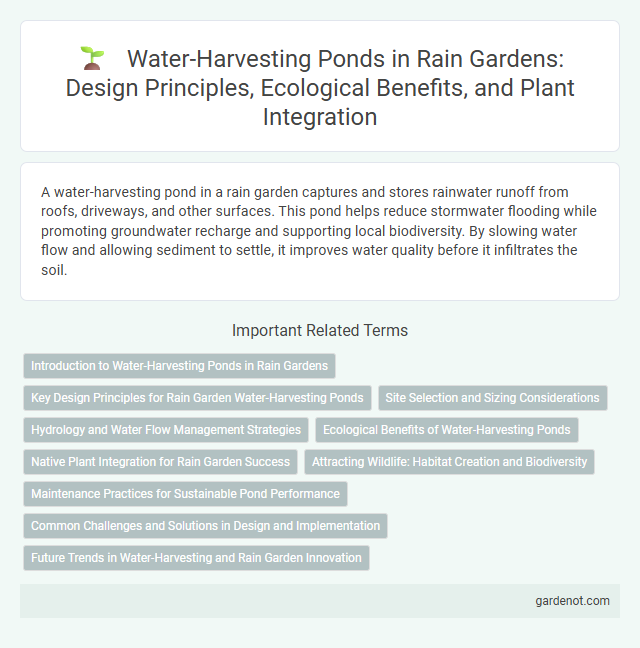A water-harvesting pond in a rain garden captures and stores rainwater runoff from roofs, driveways, and other surfaces. This pond helps reduce stormwater flooding while promoting groundwater recharge and supporting local biodiversity. By slowing water flow and allowing sediment to settle, it improves water quality before it infiltrates the soil.
Introduction to Water-Harvesting Ponds in Rain Gardens
Water-harvesting ponds in rain gardens serve as crucial features for collecting and storing stormwater runoff, reducing surface water flow and promoting groundwater recharge. These ponds enhance the filtration of pollutants, sediments, and nutrients through natural processes before water infiltrates the soil, contributing to improved water quality. By capturing rainwater on-site, water-harvesting ponds mitigate urban flooding while supporting plant growth and biodiversity within the rain garden ecosystem.
Key Design Principles for Rain Garden Water-Harvesting Ponds
Rain garden water-harvesting ponds require careful design to maximize stormwater capture and infiltration, emphasizing a properly graded basin with a gentle slope to prevent erosion and ensure even water distribution. Incorporating native, drought-tolerant plants with deep roots enhances water absorption and improves soil structure, while installing an overflow mechanism protects the pond from overflow during heavy rainfall. The pond's bottom should be lined with permeable materials to facilitate water infiltration into the groundwater, optimizing the pond's efficiency in reducing runoff and promoting groundwater recharge.
Site Selection and Sizing Considerations
Selecting a site for a water-harvesting pond in a rain garden requires evaluating soil permeability, slope, and proximity to structures to ensure effective water capture and infiltration. The pond size should be determined based on watershed area, expected runoff volumes, and rainfall intensity, with capacity typically designed to manage the first flush of stormwater to reduce overflow and maximize groundwater recharge. Incorporating native vegetation and proper grading enhances sediment control and supports pond function within the rain garden ecosystem.
Hydrology and Water Flow Management Strategies
A water-harvesting pond in a rain garden captures and stores stormwater runoff, enhancing infiltration and reducing surface water flow. Its design incorporates graded slopes and permeable soils to control hydrology by directing water efficiently through the catchment area. Strategic placement and sizing ensure optimal water retention, minimizing erosion and groundwater contamination while promoting groundwater recharge.
Ecological Benefits of Water-Harvesting Ponds
Water-harvesting ponds in rain gardens enhance groundwater recharge by collecting and slowly infiltrating stormwater, reducing surface runoff and erosion. These ponds create habitats that support diverse aquatic and terrestrial species, promoting local biodiversity and ecosystem stability. By filtering pollutants and sediments from runoff, water-harvesting ponds improve water quality and contribute to healthier urban and natural environments.
Native Plant Integration for Rain Garden Success
Water-harvesting ponds in rain gardens enhance stormwater management by capturing and slowly infiltrating runoff, promoting groundwater recharge. Integrating native plants such as black-eyed Susans, switchgrass, and redtwig dogwood optimizes pollutant filtration, erosion control, and habitat creation within these ponds. Native vegetation's deep root systems improve soil structure and water retention, ensuring long-term rain garden sustainability and ecological benefits.
Attracting Wildlife: Habitat Creation and Biodiversity
A water-harvesting pond in a rain garden creates essential habitats that attract diverse wildlife, including amphibians, birds, and beneficial insects. The pond supports biodiversity by providing a consistent water source and shelter, promoting ecosystem balance. Vegetation around the pond enhances habitat complexity, further encouraging species richness and ecological resilience.
Maintenance Practices for Sustainable Pond Performance
Effective maintenance practices for a water-harvesting pond in a rain garden include regular sediment removal to prevent clogging and maintain optimal water infiltration. Inspecting and clearing inlet and outlet structures ensure uninterrupted water flow, reducing the risk of overflow during heavy rainfall. Periodic vegetation management promotes healthy plant growth that stabilizes soil and enhances pollutant filtration, supporting sustainable pond performance.
Common Challenges and Solutions in Design and Implementation
Water-harvesting ponds in rain garden design often face challenges such as poor soil infiltration, leading to waterlogging, and sediment accumulation that reduces storage capacity. Solutions include selecting permeable soil mixtures, incorporating underdrain systems to enhance drainage, and installing sediment traps to maintain pond functionality. Proper grading and vegetation selection further optimize water retention and prevent erosion, ensuring efficient stormwater management.
Future Trends in Water-Harvesting and Rain Garden Innovation
Water-harvesting ponds integrated within rain gardens are increasingly incorporating smart sensors and IoT technology to optimize water retention and improve stormwater management. Emerging trends emphasize sustainable materials and bioengineered designs that enhance groundwater recharge and support biodiversity. Advanced modeling software enables precise planning and real-time monitoring, driving innovation in urban water management and climate resilience.
Water-harvesting pond Infographic

 gardenot.com
gardenot.com